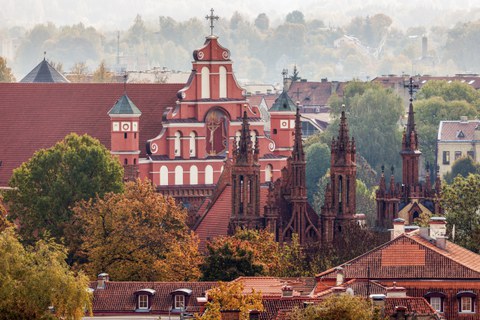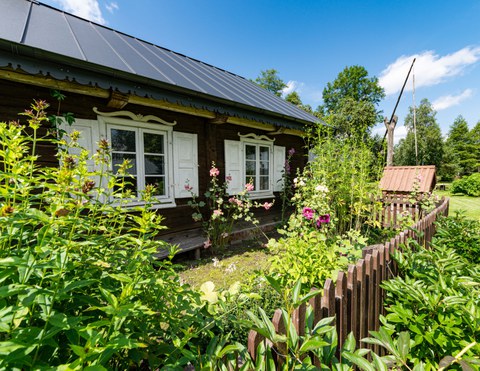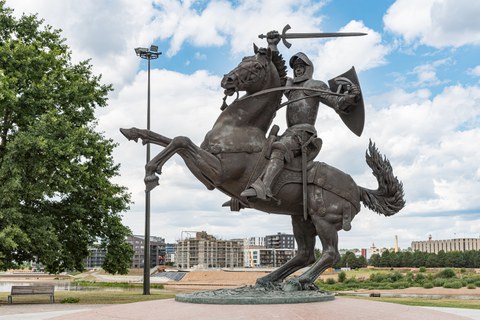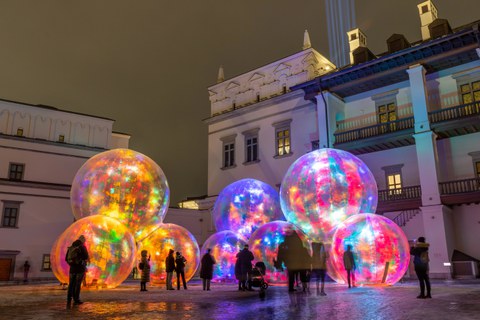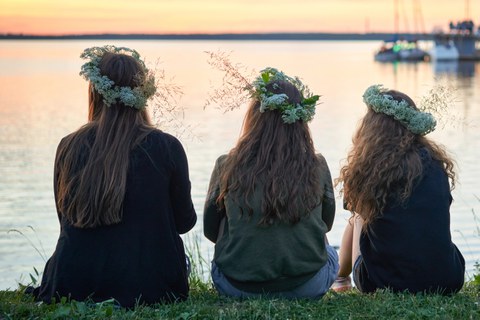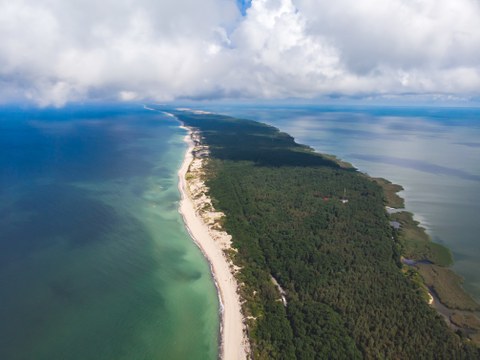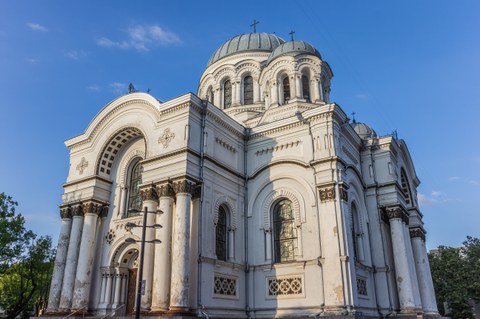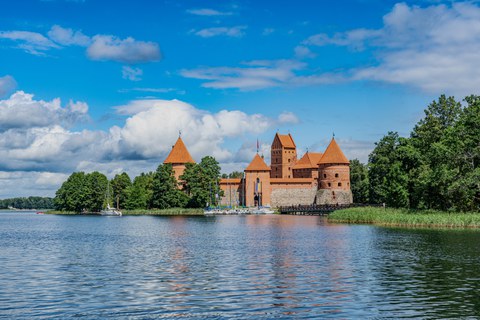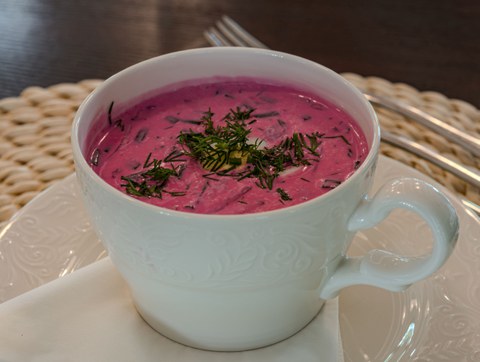Partner Country of the Month May 2025: Lithuania
Lithuania, located on the eastern shore of the Baltic Sea, is the largest and southernmost of the three Baltic states. Currently, Lithuania features in geopolitical news, but how much do you really know about the country and its culture? There is a lot to discover: Lively traditions like the Midsummer Festival, the rich and varied history of Lithuania, and wonderful nature with many lakes, forests and the sandy beaches of the Baltic Sea. Our partner cities Vilnius and Kaunas are waiting.
With the "Partner Country of the Month" campaign, we want to shine a spotlight on the wide diversity of countries, regions and partner universities of TU Dresden that our students can explore during a semester abroad.
Table of contents
General facts and figures about Lithuania
Lithuanian name: Lietuva
Capital: Vilnius
Population: 3 million
Official language: Lithuanian
National holiday: there are 3 – the founding of the first Lithuanian state (July 6), and independence from the Russian Empire (February 16) and the Soviet Union (March 11)
Currency: Euro
You can find further facts, figures and information on Wikipedia, on the website of the German Federal Foreign office, or on wikivoyage and lithuania.travel.
Language matters
- Hello – Sveiki [sveyky]
- Good day – Laba diena [laba dyena]
- What's your name? – Koks tavo vardas?
- Okay / good – Gerai
- Please – Prašau [prashau]
- Thank you – Ačiū [achoo]
- See you – Viso
Lithuanian and Latvian constitute the Baltic languages, a language group which (contrary to common assumptions) has no close ties to Slavic or Germanic languages. Instead, they have retained a lot of archaic characteristics, showing pronounced similarities to Sanskrit and Latin. Lithuanian especially still shows many ancient features, making it a crucial source of information in attempts to reconstruct the ancestral language of the Indo-European language family.
Unfortunately, the archaic features of Lithuanian include complex grammar rules. However, Lithuanians will be delighted about any attempts at learning and speaking the language of their small country, even if your grammar is not perfect. You can study Lithuanian with the Easy Lithuanian textbooks and use online resources like Spoken Lithuanian. VHS Dresden offers a small introduction (starting from German).
You do not need to fear the language barrier during your exchange. Our partner universities offer a wide range of courses in English and it's absolutely possible to study entirely in English during a semester abroad. Please check the requirements at your university of choice before applying. Usually, language skills at B2 level are sufficient. If needed, you can join the preparation course for a period abroad at TUDIAS.
Did you know that ....?
- there is an independent republic right in the middle of Lithuania’s capital? The tiny Republic of Užupis was founded on April 1, 1997, which casts some doubt on the seriousness of the founders. Inhabited mainly by artists and other free spirits, Užupis has a president, a cabinet, an army (of 11 people) and, of course, a constitution. Its articles range from community-minded (Everyone has the right to hot water, heating in winter, and a tiled roof) and profound (No one has the right to have a design on eternity) to charmingly weird (A cat is not obliged to love its owner, but must help in times of need.)
- Lithuania has a strong laser industry, specializing in scientific and industrial lasers? Lithuanian lasers are used by CERN and other renowned research institutions, and in fields such as the semiconductor industry.
-
the longest human chain in history was formed in the Baltic States? On 23 August 1989, two million people joined hands, connecting the three capitals Vilnius (Lithuania), Riga (Latvia) and Tallinn (Estonia) over a total length of about 650 kilometres. The occasion was the 50th anniversary of the Hitler-Stalin Pact, in which the three Baltic countries were assigned to the Soviet Union. People protested against the occupation and called for freedom and independence.
-
Lithuania is the only country in the world to have a national scent? The Scent of Lithuania combines essences of wildflowers, raspberries, sandalwood and musk, and is supposed to represent the country symbolically and emotionally. Notes of moss and woodsmoke evoke old pagan customs like the midsummer celebrations that still form part of Lithuanian culture today. The Scent of Lithuania is sold as a perfume or scented candle.
-
even proper names are “Lithuanized”? In order to fit in with Lithuanian grammar, words of foreign origin get Lithuanian endings such as -is, -as and -us (masculine), or -a and -ė (feminine). This applies to personal names as well. Until recently, it was also common and even mandatory on legal documents to adopt Lithuanian spelling for names. Nowadays, however, you are more likely to encounter Williamas Shakespearas than Vilijamas Šekspyras.
-
a village in Lithuania is the best candidate for the geographic midpoint of Europe? Surprisingly many countries claim this title, including Poland, Czech Republic, Ukraine, Estonia and Belarus. Europe‘s boundaries to Asia had long been vaguely defined, and there are various ways of resolving the question of how to include islands and maritime areas. Purnuškės near Vilnius is often considered to have the most well-founded claim, calculated by French Institut Géographique National.
Cooperations with Universities in Lithuania
You can find all cooperations of TU Dresden in our database. Have a look at the experiences of our previous exchange students at Questionnaires. Professors at your faculty may have direct contacts to your partner university of choice and can advise you.
Our cooperations with Lithuanian universities are part of Erasmus+. You can find the contact persons and application deadlines for your faculty here.
Our cooperations via Erasmus+
- Vytautas Magnus University in Kaunas
- Forestry
- Vilniaus Universitetas in Vilnius
- Business Administration and Economics
- Slavic Studies
- International Relations
- Physics
- IHI Zittau (Social and Business Studies)
- Vilniaus Gedimino Technikos Universitetas (VGTU) in Vilnius
- Civil Engineering
- European Humanities University in Vilnius
- Slavic Studies
Don't miss...
The summer solstice and equinoxes are Lithuania‘s most important festivals, celebrated with large bonfires and ancient chants. Around March 21, candlelight sun wheels accompany the victory of the Sun over winter. On June 24, Lithuanians spend the shortest night of the year in nature, adorned with flower wreaths. And around September 21, the burning of straw figures and symbols shows thanks for the harvest. The autumn equinox coincides with Baltic Unity Day, commemorating the victory of the pagan Balts against German crusaders in the 13th century – thanks to the late Christianization of the area, the old festivals never wholly disappeared. Kernavė Archaeological Site and Verkiai Regional Park in Vilnius are great locations to join in the celebrations.
The Curonian Spit is an oddity of nature, a narrow ribbon of sand stretching across the Baltic Sea coast, forming Europe’s longest sandy beach at its seaward side. While the spit is mostly covered in forests, some areas contain vast shifting sand dunes that have swallowed up entire villages over the centuries. The Parnidis Dune close to Nida is especially worth seeing. While the northern half of the Curonian Spit is Lithuanian, the southern half belongs to Russia (Oblast Kaliningrad). You can reach the Lithuanian part via the port city of Klaipėda.
Kaunas Museum for the Blind is hidden in the pitch-black catacombs of St. Michael the Archangel Church in our partner city of Kaunas. You can experience an hour in a blind person’s shoes by exploring the exhibition by touch, sound, and smell, letting your senses lead you around the rooms with their textures, soundscapes and scents. The museum’s collection contains artwork by blind artists and many objects from blind culture and daily life. Find out more about your visit at Kaunas City Information.
Trakai Island Castle near Vilnius is not only very picturesque, but also important for Lithuanian history. In the 14th century, it was the seat of Lithuanian Grand Dukes and national heroes Gediminas and Vytautas, after whom many Lithuanians are still named today. You can learn more at the castle museum or travel back in time during the yearly medieval festival in June. The historical town of Trakai is also worth seeing, and you can relax on the shores of beautiful Lake Galvė.
Let's get cooking...
Lithuanian food culture is related to that of its neighboring countries Latvia, Russia, Belarus, and especially Lithuania’s former union partner Poland. Similarities show in the large variety of dumpling dishes, usually served with sour cream. Potatoes, buckwheat and rye bread are important staple foods, while caraway seeds, marjoram, parsley, and dill are popular for seasoning.
Lithuanian cuisine features many cold dishes that are perfect to eat as a snack, including smoked meats (such as salo) and a variety of cheeses and other dairy products. The white cheese Varškės sūris is particularly versatile – it can be used as an ingredient in dishes such as pancakes, dumplings or cheesecake, but can also be drizzled with honey and enjoyed on its own. Other Lithuanian classics include cepelinai, stuffed potato dumplings named after their zeppelin-like shape. The most popular dessert for celebrations of all kinds is the spit cake Šakotis, which is prepared with 30 to 50 eggs per kilogram of flour and available in countless sizes and weights.
Šaltibarščiai [shaltibarshchey]
This strikingly pink soup is the perfect Lithuanian summer dish (and also makes for a great hangover cure). Peak Šaltibarščiai season lasts from May to September, kicked off by its own festival in Vilnius. Preparing the soup is quick and easy. Šaltibarščiai is served cold, with plenty of dill and a side of steaming hot potatoes. You can find an authentic recipe for Šaltibarščiai at tasteatlas.com. Gero apetito!
Contact
Have you had a great time in Lithuania? Do you have tips for places and experiences that are not to be missed? We would be happy to share your experiences here, on social media or, if you want, in information events for other TUD students. Get in touch with us:
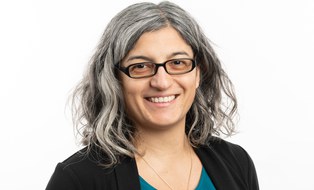 © Sven Ellger/TUD
© Sven Ellger/TUD
Advice on studying abroad
NameMs Federica Serra
Infocenter/ Study abroad; TUDworldwide: America
Send encrypted email via the SecureMail portal (for TUD external users only).
Visiting address:
Fritz Foerster Bau, Office 161 Mommsenstraße 6
01069 Dresden
Postal address:
TUD Dresden University of Technology International Office
01062 Dresden
Office hours:
- Tuesday:
- 09:30 - 11:30
- 12:30 - 14:30
- Thursday:
- 09:30 - 11:30
Please register at the SCS (FOE, floor 0).
Looking for first-hand information?
Would you like to know more about Lithuania? Ask our alumni ambassadors - TUD alumni who are active in many countries around the world and can give you information and advice for your stay abroad.
Getting in touch is very easy: On this interactive world map, markers indicate the cities where our alumni ambassadors live. There is a short profile with contact information for each ambassador.
Partner Countries Archive
Have you missed a partner country? No worries! Here you can read up on all articles.
|
Europe (Erasmus+) |
|
|
Africa |
|
|
America |
|
|
Asia |
|
|
Australia and Oceania |
|

